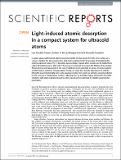Files in this item
Light-induced atomic desorption in a compact system for ultracold atoms
Item metadata
| dc.contributor.author | Torralbo-Campo, Lara | |
| dc.contributor.author | Bruce, Graham David | |
| dc.contributor.author | Smirne, Giuseppe | |
| dc.contributor.author | Cassettari, Donatella | |
| dc.date.accessioned | 2015-10-15T13:40:01Z | |
| dc.date.available | 2015-10-15T13:40:01Z | |
| dc.date.issued | 2015-10-13 | |
| dc.identifier | 156036943 | |
| dc.identifier | 2d4bb557-8288-4e0f-a00c-3a941f36db4e | |
| dc.identifier | 84944345326 | |
| dc.identifier | 000362635300001 | |
| dc.identifier.citation | Torralbo-Campo , L , Bruce , G D , Smirne , G & Cassettari , D 2015 , ' Light-induced atomic desorption in a compact system for ultracold atoms ' , Scientific Reports , vol. 5 , 14729 . https://doi.org/10.1038/srep14729 | en |
| dc.identifier.issn | 2045-2322 | |
| dc.identifier.other | ArXiv: http://arxiv.org/abs/1312.6442v2 | |
| dc.identifier.other | ORCID: /0000-0003-3403-0614/work/27379860 | |
| dc.identifier.other | ORCID: /0000-0003-3571-6642/work/93161390 | |
| dc.identifier.uri | https://hdl.handle.net/10023/7656 | |
| dc.description | This work was supported by the UK EPSRC grant GR/T08272/01 and the Leverhulme Trust Research Project Grant RPG-2013-074. G.S. acknowledges support from a SUPA Advanced Fellowship. | en |
| dc.description.abstract | In recent years, light-induced atomic desorption (LIAD) of alkali atoms from the inner surface of a vacuum chamber has been employed in cold atom experiments for the purpose of modulating the alkali background vapour. This is beneficial because larger trapped atom samples can be loaded from vapour at higher pressure, after which the pressure is reduced to increase the lifetime of the sample. We present an analysis, based on the case of rubidium atoms adsorbed on pyrex, of various aspects of LIAD that are useful for this application. Firstly, we study the intensity dependence of LIAD by fitting the experimental data with a rate-equation model, from which we extract a correct prediction for the increase in trapped atom number. Following this, we quantify a figure of merit for the utility of LIAD in cold atom experiments and we show how it can be optimised for realistic experimental parameters. | |
| dc.format.extent | 534087 | |
| dc.language.iso | eng | |
| dc.relation.ispartof | Scientific Reports | en |
| dc.subject | QC Physics | en |
| dc.subject | DAS | en |
| dc.subject.lcc | QC | en |
| dc.title | Light-induced atomic desorption in a compact system for ultracold atoms | en |
| dc.type | Journal article | en |
| dc.contributor.sponsor | The Leverhulme Trust | en |
| dc.contributor.sponsor | EPSRC | en |
| dc.contributor.institution | University of St Andrews. School of Physics and Astronomy | en |
| dc.contributor.institution | University of St Andrews. Condensed Matter Physics | en |
| dc.identifier.doi | https://doi.org/10.1038/srep14729 | |
| dc.description.status | Peer reviewed | en |
| dc.identifier.url | http://www.nature.com/articles/srep14729#additional-information | en |
| dc.identifier.grantnumber | RPG-2013-074 | en |
| dc.identifier.grantnumber | GR/T08272/01 | en |
This item appears in the following Collection(s)
Items in the St Andrews Research Repository are protected by copyright, with all rights reserved, unless otherwise indicated.

